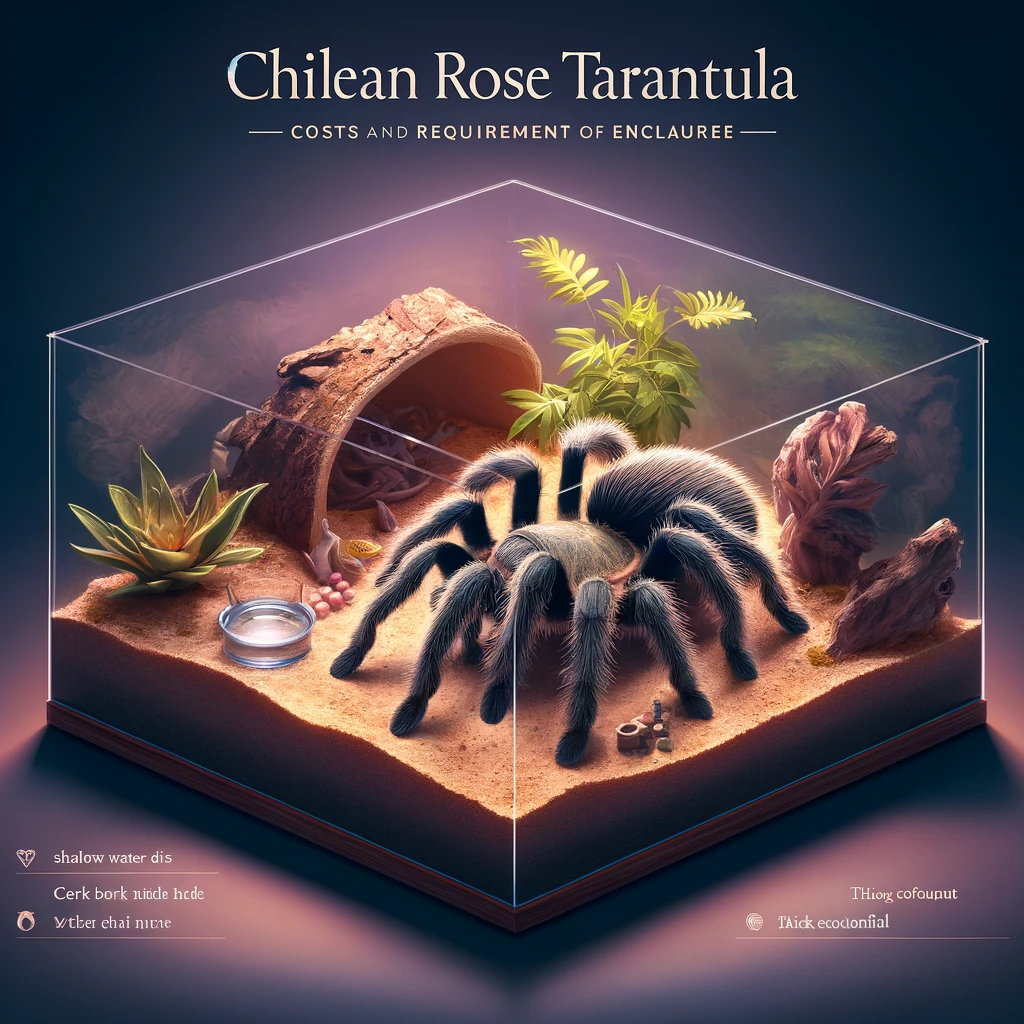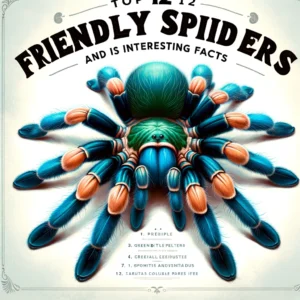The Chilean Rose Tarantula, also known as the Rose Hair Tarantula, is a popular pet spider known for its docile temperament and relatively easy care. To ensure the health and well-being of a Chilean Rose Tarantula, setting up the proper enclosure is crucial. Here’s a comprehensive guide on how to prepare an enclosure that mimics their natural habitat and meets all their needs.
Essential Requirements
Setting up an enclosure for a Chilean Rose Tarantula involves various components, with costs ranging from $73 to $210. Essential items include a 5-10 gallon tank ($15-$50), substrate like coconut fiber ($5-$15), and a heating mat ($20-$35). Humidity and temperature control are critical, necessitating a hygrometer and thermometer ($20-$35). Decorative elements like hides and plants add comfort ($15-$55), while a shallow water dish is a must ($1-$5). Optional lighting can also be included ($10-$30). This setup ensures a healthy, comfortable environment for the spider, mimicking its natural habitat as closely as possible.

Enclosure Type
Size:
- Adults: A 5 to 10-gallon tank is typically sufficient for a single adult Chilean Rose Tarantula. The enclosure should be more horizontal than vertical as these spiders are more terrestrial and do not often climb.
- Spiderlings: A smaller enclosure such as a 2 to 5-gallon tank can be used for spiderlings to prevent them from having difficulty finding their food.
Material:
- Glass or Plastic: Both are suitable, but glass is more durable and provides a better view of your pet. However, plastic may retain humidity better and is lighter for transportation.
Substrate
Type:
- A mix of peat moss, soil, coconut fiber, or vermiculite works well. These materials hold moisture and allow the spider to burrow.
Depth:
- The substrate should be 3-4 inches deep to allow for burrowing, which is a natural behavior for these spiders.
Temperature and Humidity
Temperature:
- Daytime: 70-80°F (21-27°C)
- Nighttime: Can drop to as low as 60°F (15°C)
- Use a heat mat placed on the side of the tank (not underneath, to prevent overheating) to maintain these temperatures.
Humidity:
- Maintain humidity levels at around 60-70%.
- This can be achieved by misting the enclosure every few days. Avoid making the substrate soggy.
Lighting
- Chilean Rose Tarantulas do not require special UV lighting. Ambient room light is sufficient, and they prefer dim conditions as they are nocturnal.
Decoration and Hiding Spots
- Hides: Provide hiding spots such as cork bark, half-logs, or clay flowerpots turned on their sides. These provide the spider with a sense of security.
- Plants: Artificial plants can be added for decoration and to provide additional hiding spots.
- Climbing: While not necessary, a piece of driftwood or similar can be provided for occasional climbing.
Water
- A shallow water dish should be included in the enclosure. Ensure the sides are low enough for the spider to access easily. Change the water regularly and clean the dish to prevent the growth of bacteria.
General Tips
- Location: Place the tank in a low-traffic area to reduce stress for the spider.
- Cleaning: Regularly remove uneaten food, mold, and feces from the enclosure. Clean the entire tank and replace the substrate every few months.
- Handling: Minimize handling as much as possible. While Chilean Rose Tarantulas are known for their calmness, they can become stressed and may flick urticating hairs or even bite if provoked.

Estimating the Cost of a Chilean Rose Enclosure
Setting up an enclosure for a Chilean Rose Tarantula involves various components, each with its own cost. The overall price can vary significantly depending on the choices you make regarding quality, size, and additional features. Here’s a breakdown of the estimated costs involved in setting up a suitable habitat for a Chilean Rose Tarantula:
1. Enclosure (Tank)
- Glass Tank (5-10 gallons): Typically costs between $20 to $50, depending on the size and quality. You can sometimes find cheaper tanks second-hand.
- Plastic Enclosures: These may be slightly cheaper, ranging from $15 to $40.
2. Substrate
- Coconut Fiber, Peat Moss, or Vermiculite: A bag of substrate generally costs around $5 to $15, which should be enough to cover a few changes of substrate in the tank.
3. Heating
- Heat Mat: A small heat mat suitable for a 5-10 gallon tank typically costs around $15 to $25.
- Thermometer: To monitor the temperature, a simple thermometer might cost between $5 and $10.
4. Humidity Control
- Hygrometer: To measure humidity levels, a basic hygrometer costs about $5 to $15.
- Misting Bottle: A simple spray bottle can be purchased for around $2 to $5.
5. Decorations and Hides
- Hides (Cork Bark, Half-Logs): These can cost between $5 to $20, depending on the material and size.
- Artificial Plants: Optional, but if added, can cost between $5 to $15.
- Driftwood or Climbing Sticks: Typically around $5 to $20.
6. Water Dish
- A simple shallow water dish costs about $1 to $5.
7. Lighting (Optional)
- Basic LED or Incandescent Fixture: If you choose to provide additional lighting, a simple fixture might cost between $10 to $30, plus a few dollars for the bulb.
Summary of Costs
| Item | Cost Range (USD) |
|---|---|
| Enclosure (Tank) | $15 – $50 |
| Substrate | $5 – $15 |
| Heating (Mat + Thermometer) | $20 – $35 |
| Humidity Control (Hygrometer + Misting Bottle) | $7 – $20 |
| Decorations and Hides | $15 – $55 |
| Water Dish | $1 – $5 |
| Lighting | $10 – $30 |
| Total Estimated Cost | $73 – $210 |
These costs are estimates and could be lower or higher based on specific product choices, sales, discounts, or regional price variations. Shopping online, at local pet stores, or checking out second-hand options can also affect the final cost. This setup aims to provide everything needed for a healthy and comfortable environment for your pet tarantula.
By following these guidelines, you can create a comfortable and stimulating environment for your Chilean Rose Tarantula, ensuring it remains healthy and active. Always monitor the conditions inside the enclosure and adjust as needed to mimic natural habitats as closely as possible.
FAQs
How often should I mist my Chilean Rose Tarantula’s enclosure?
Misting should be done every few days to maintain humidity levels around 60-70%, but ensure the substrate is not soggy.
What kind of hides and decorations are suitable for a Chilean Rose Tarantula?
Provide hides such as cork bark, half-logs, or upside-down clay flowerpots. Decorations like artificial plants can add aesthetic value and additional hiding spots.
Do I need to install lighting in my Chilean Rose Tarantula’s enclosure?
Chilean Rose Tarantulas do not require special UV lighting; ambient room light is sufficient, with dim conditions preferable as they are nocturnal.
What type of water dish is best for a Chilean Rose Tarantula?
A shallow dish with low sides is perfect, ensuring the spider can easily access the water without the risk of drowning. Clean and refill the dish regularly.
How often should the enclosure be cleaned?
Regular spot cleaning to remove uneaten food, mold, and feces is advised, with a thorough cleaning and substrate change every few months.
Can I handle my Chilean Rose Tarantula often?
Handling should be minimized to reduce stress on the spider. Although they are known for their docile nature, they can flick urticating hairs or bite if provoked.
Is a Chilean Rose Tarantula a good choice for beginner tarantula owners?
Yes, their calm demeanor and relatively simple care requirements make them an excellent choice for beginners looking to enter the world of arachnid pet ownership.

Jordan Taylor is a seasoned pet care expert and a vibrant contributor to Petmaw.com. With over a decade of experience in veterinary science, Jordan brings a wealth of knowledge and a deep passion for animals to every article. After earning a degree in Veterinary Medicine from the University of Alaska Anchorage, Jordan spent several years working in a busy veterinary clinic, where they honed their skills in pet nutrition, behavior, and wellness.
Jordan’s love for animals isn’t just professional; it’s a fundamental part of their life. Home is shared with three rescue Sloth, two cats, and a small flock of backyard chickens, each with their own rescue story and special place in Jordan’s heart. This personal connection to animals shines through in Jordan’s writing, making their advice not only expert but also empathetic and practical for pet owners.
At Petmaw.com, Jordan is dedicated to providing pet owners with the latest research, trends, and tips in pet care, from innovative feeding strategies to understanding the subtle signs of pet health issues. Whether you’re a seasoned pet owner or new to the pet parenting world, Jordan’s insights aim to enhance the well-being of pets and deepen the human-animal bond.
In their spare time, Jordan is an avid hiker, often found exploring the trails with their dogs. They also volunteer at local animal shelters, offering their expertise and helping animals in need find forever homes. Jordan’s commitment to animal welfare and passion for sharing knowledge makes them a cherished member of the Petmaw.com family and a trusted guide for our readers.





